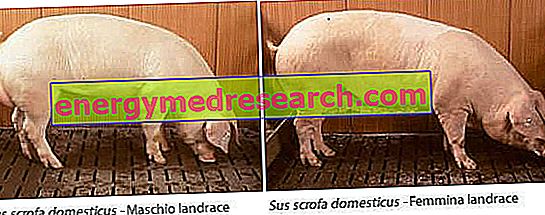According to Italian legislation, olive oil is the product of the pressing of the fruits of European Olea Leccino.
Olea europea Leccino - Ulivo
The European Olea, commonly called olive tree, is a plant belonging to the family of oleaceae that differs further in two botanical species: Olea europea sativa and Olea europea oleaster (more than 30 wild species).

Italy is a strongly olive-growing nation, so much so that, on a theoretical level, only two regions out of twenty (Piedmont and Valle d'Aosta) are NOT characterized by the cultivation (even minimal) of the olive tree; moreover, as it is easy to understand, most of the Italian oil comes from the south of the peninsula (85% of the total): Puglia, Calabria, Basilicata, Sicily and Sardinia.
Curiosity : The olive tree is the plant subject to production fluctuations par excellence; it is characterized by poor yields (called yields) followed by years of vegetative production and high yielding fruits (called discharge).
Olive
The fruit or drupe of the European sativa Olea is called olive; the olive is characterized by a weight that can oscillate between 1.5 and 4.5 grams and is structurally composed of:
- Epicarp or peel 1.5-3%: it is a thin and elastic external membrane (epidermis) of variable color depending on the state of maturation (from chlorophyll green to red or black - anthocyanins ), covered with a protective waxy substance, the bloom (with protective screen function against pests and microorganisms)
- Pulp 70-80%: it has a fleshy consistency and a variable color; mainly contains water and esterified lipids (oil).
- Endocarp or hazel 15-25%: it is a woody "shell" that contains the seed also called "almond" (achene - 2.5-4% of the weight). The core is in turn divisible into endosperm, episperm and embryo

NB. the olive achene is indehiscent for the human intestine.
Nutritional Values Oliva Matura
The ripe olive, therefore ready for pressing for the production of oil, has a chemical composition that can be summarized as follows:
- Water 45-55%: it is the most present component in the fruit
- Lipids 13-28%: portion useful for the composition of the oil
- Nitrogenous substances 1.5-2%:
- Non-nitrogenous compounds 18-24%
- Crude fiber 5-8%
- Ashes 1-2%

Types of oil
The types of oil obtained from the collection and pressing of the olive can be classified into 3 groups:
- Oils obtained by mechanical means; they are three, but of these only two are directly edible: the extra virgin and the virgin . The third, called lampante (because once used as fuel for lamps) to become edible requires a refining process.
In 2003 a fourth was defined, called the current virgin, not available at retail and used only industrially for cuts and mixtures of other oils.
- Refined lamp oil: purified by means of chemical-physical procedures to eliminate the NOT edible components. When mixed with virgin oil, it is marketed under the name of olive oil .
- Oils extracted with chemical solvents from the processing residue ( pomace ); they too are refined and then mixed with virgin oils to be marketed as pomace oil .
Olive harvesting methods
The olive harvesting methods are many and different; these are variable techniques for: level of automation, level of labor, quality of selection and result of collection. The methods are:
- Gathering, which in turn includes:
- Spontaneous fall
- Combing
- Olive shaking
- downhearting
- Hand burn
Extraction techniques
There are three techniques for extracting olive oil:
- PRESSURE (classic and discontinuous method)
- CENTRIFUGATION (modern and continuous method)
- TRAVELING through SELECTIVE FILTRATION
In the various olive oil extraction techniques it is possible to identify a common initial phase, namely:
"Initial cleaning of the drupes and subsequent milling or crushing ; the latter corresponds to a real grinding of the fruits in order to obtain an emulsion of water and lipids. On this emulsion is then applied the mixing, a procedure aimed at a further separation of the lipid fraction into larger "oily drops" is carried out by rotating metal helical blades (steel) inside a tank ".
Extraction by pressure includes a series of well-defined phases characterized by discontinuity .
On the kneaded compound a pressing is applied which separates the liquid portion from the pomace. The resulting fluid must then be centrifuged ( centrifugation ) in order to obtain a first separation of the water from the oil; the eliminated portion is called vegetation water. The resulting compound is then subjected to filtration from which virgin olive oil is obtained.
Extraction by centrifugation is instead composed of a single and continuous process that allows to obtain all three final components simultaneously; NB . extraction by centrifugation shows a high cost in terms of energy.
The extraction by centrifuge of the kneading machine exploits the difference of the 3 specific weights obtaining separately but uninterruptedly: pomace, virgin olive oil and vegetation water.
The extraction by percolation and selective filtration adopts a different physical process; this technique uses the higher surface tension of the oil than water.
A large steel sheet is immersed in the kneading machine which, with regard to the difference in surface tension between the two fluids, is mainly wet with oil; this is then removed and drained into another container.
The leachate can originate oil and must, subsequently centrifuged to extract other oil to the detriment of the vegetation water. Or it can generate oil and non-definitive pomace, from whose centrifugation you get must (treated as just described) and pomace .
One or the other method is applied based on the type and effectiveness of percolation.
Virgin oil VS extra virgin olive oil
Note how the product of the oily extraction is repeatedly called virgin and not extra virgin ; this is because, from a technical production point of view, extra virgin olive oil does NOT differ from the virgin; on the contrary, what differentiates (severely) the two products is the set of chemical and organoleptic characteristics. It is true that the extra virgin olive oil CAN be obtained with first cold pressing (at less than 27 ° C by means of a first mechanical pressing carried out on the kneading machine with hydraulic presses) or simply by cold extraction (at less than 27 ° C through percolation or centrifugation of the kneaded machine); however, although these characteristics also contribute to giving a greater or lesser quality of production, there is nothing to do with the specific production specification drawn up by the European Community (Reg. Ce 1989/2003).
To acquire the denomination exta, a virgin olive oil MUST possess a total MAXIMUM acidity (induced by free oleic acid, therefore NOT esterified with glycerol) equal to 0.8%; on the other hand, a NON-extra virgin oil can have an acidity NOT greater than 2%.
In addition to chemical analysis, it is essential that the extra product passes the organoleptic check by an applied test verified by the competent control bodies; the most valued features are: the fruity aroma (induced by volatile components) and the bitter and spicy taste (given by the polyphenols).

Chemical composition
It is possible to distinguish the composition of olive oil in two fractions:
- Saponifiable fraction: it is composed of 98-99% of triglycerides, 55% simple and 45% mixed, respectively. The fatty acid composition is variable but fundamentally it is distinguished by the high intake of palmitic acid (saturated), oleic (monounsaturated and predominant on the others), linoleic (polyunsaturated) and linolenic (polyunsaturated).
A good olive oil SHOULD be characterized by: ac. oleic not less than 73%, ac. linoleic not exceeding 10% and an oleic / linoleic ratio> 7.
- Unsaponifiable fraction: it is composed of hydrocarbons (including squalene 0.3-0.6%), phytosterols (β-sitosterol, campesterol, stigmasterol), liposoluble vitamins (3-3.7%, represented by β-carotene and tocopherols, all antioxidants), pigments (chlorophyll and carotenoids), aliphatic alcohols higher esterified to fatty acids (waxes and triterpene alcohols), polyphenols (2-3%, represented by glucosides and esters, also antioxidants)
Nutritional properties of extra virgin olive oil
Bibliography:
- Food chemistry - P. Cabras, A. Martelli - chap 10



